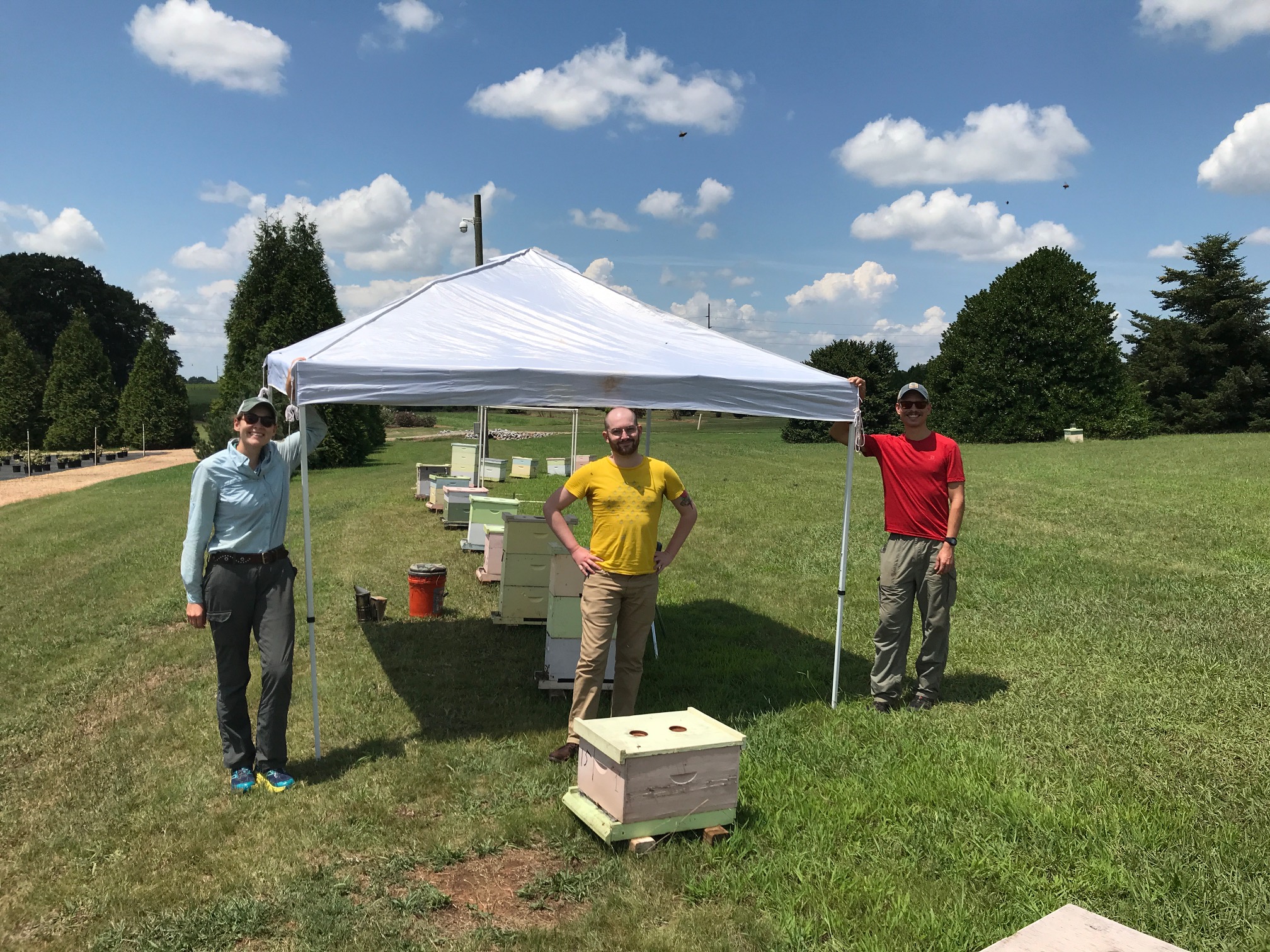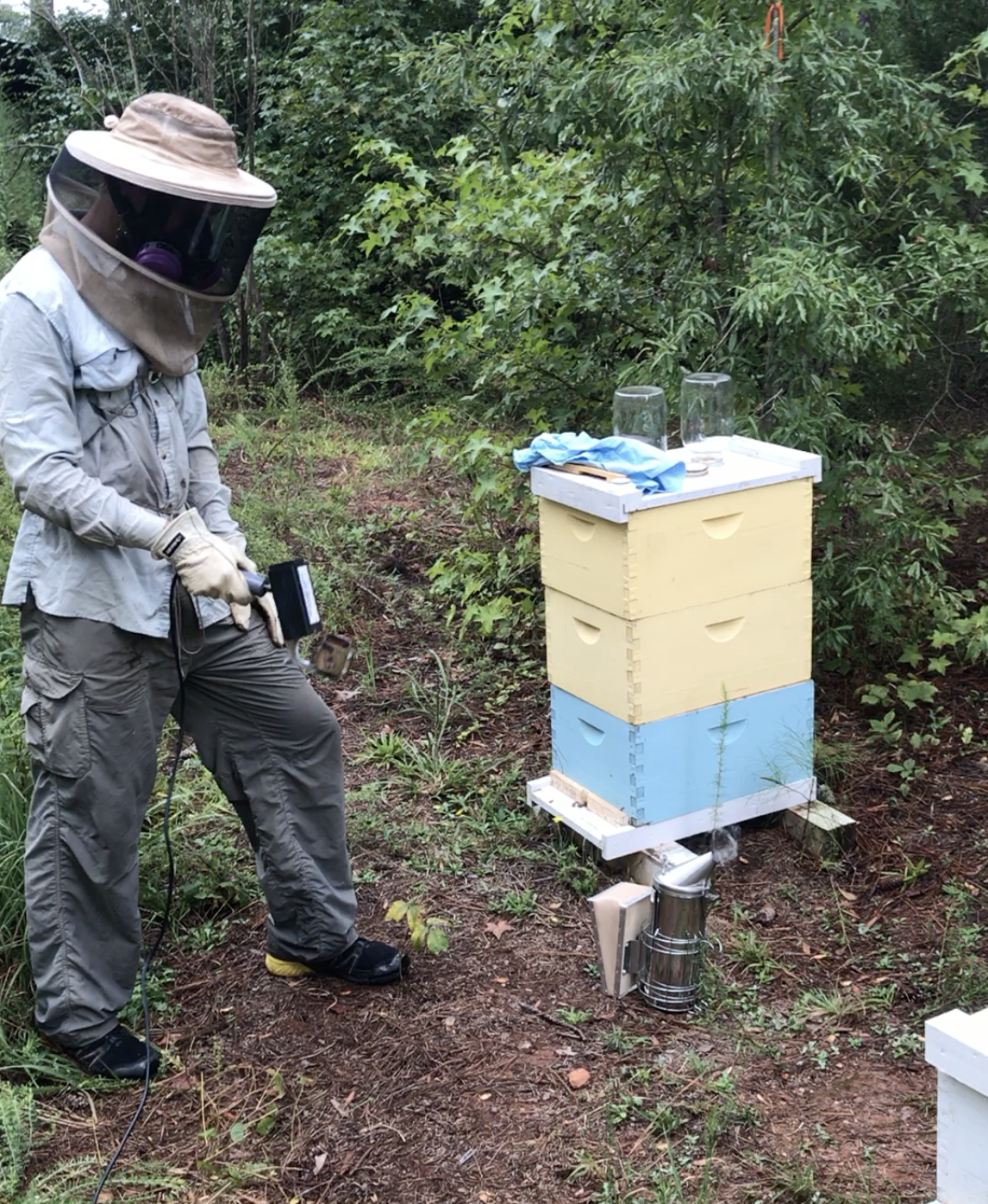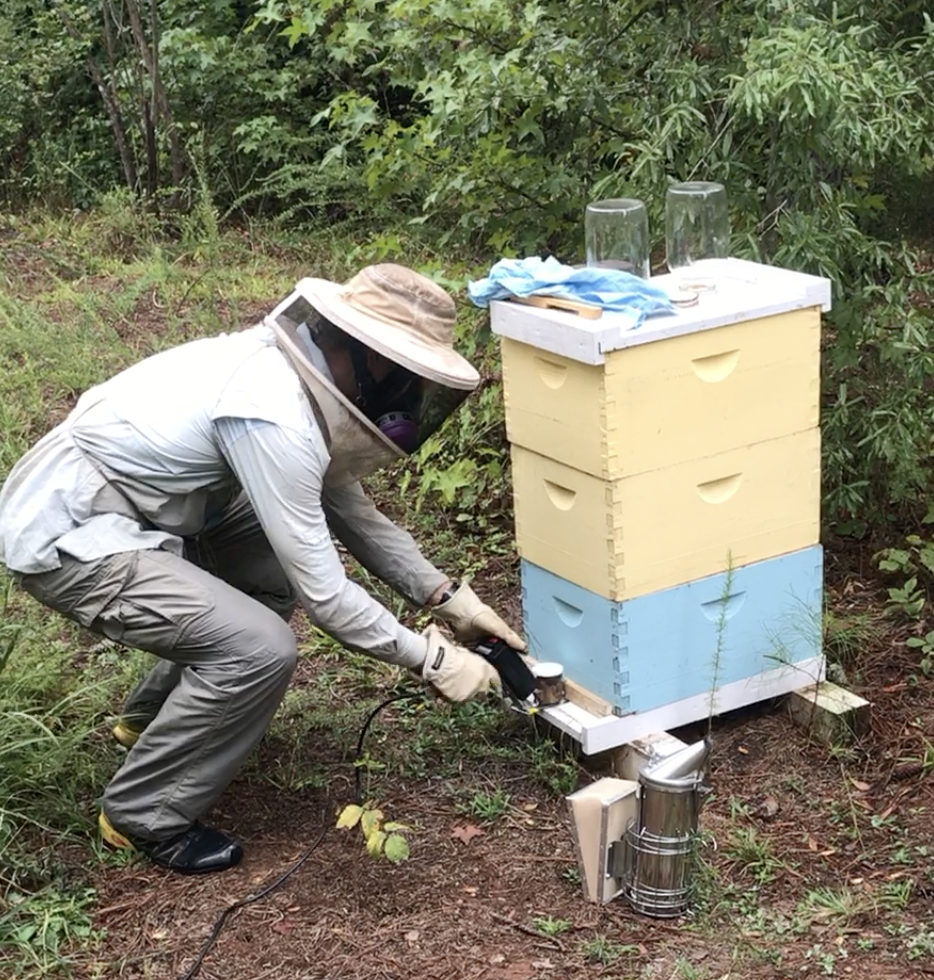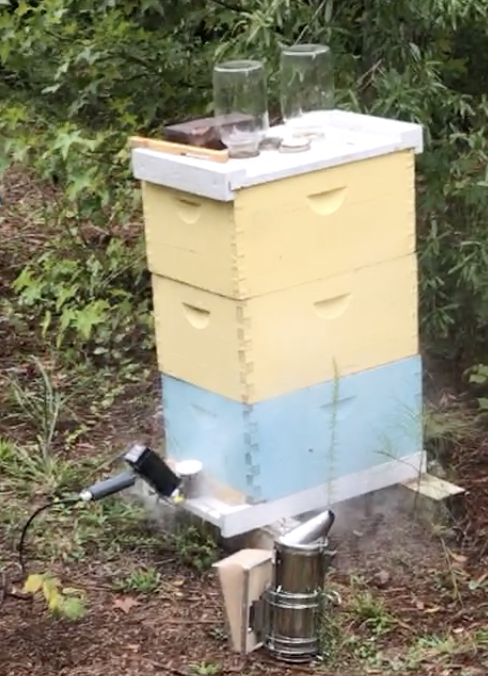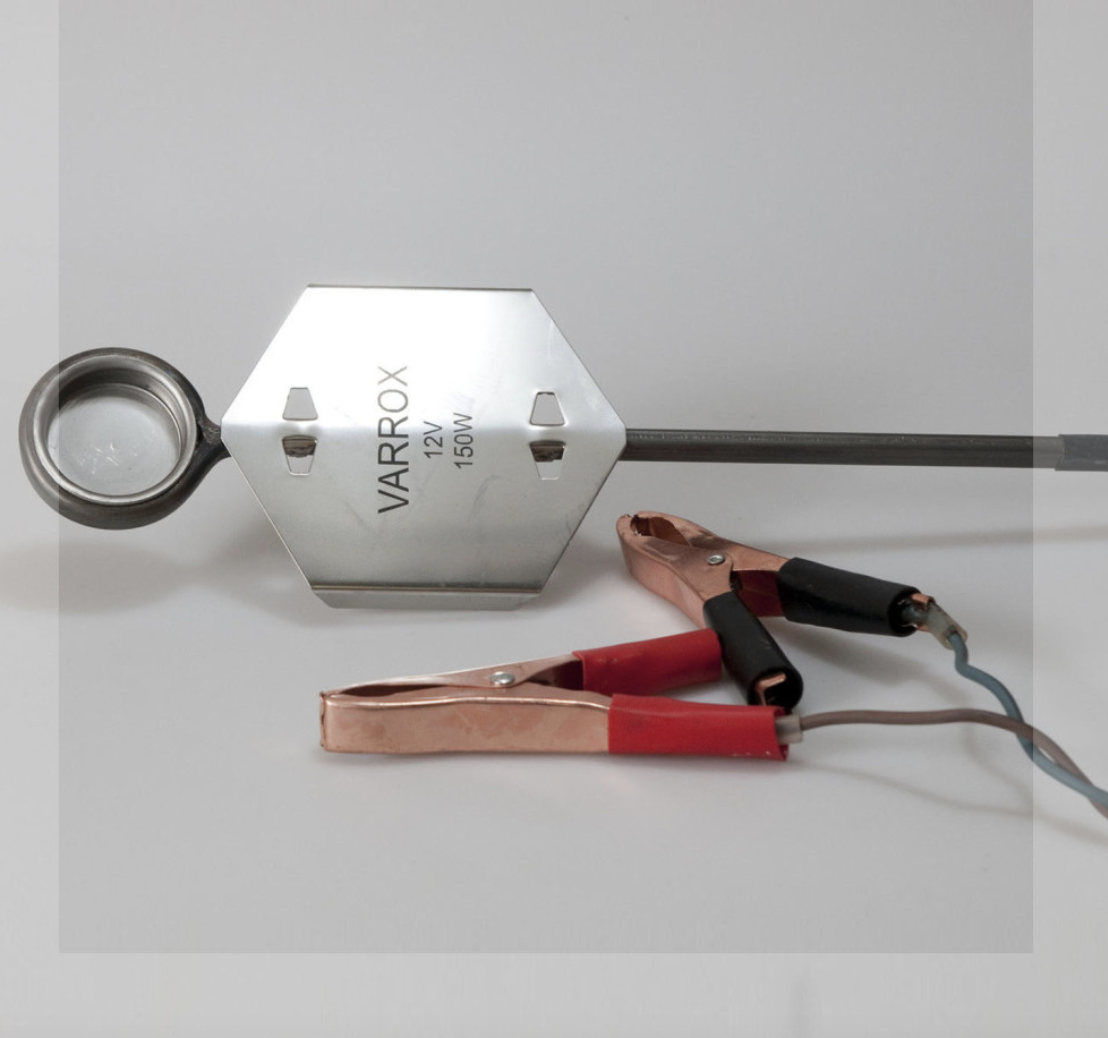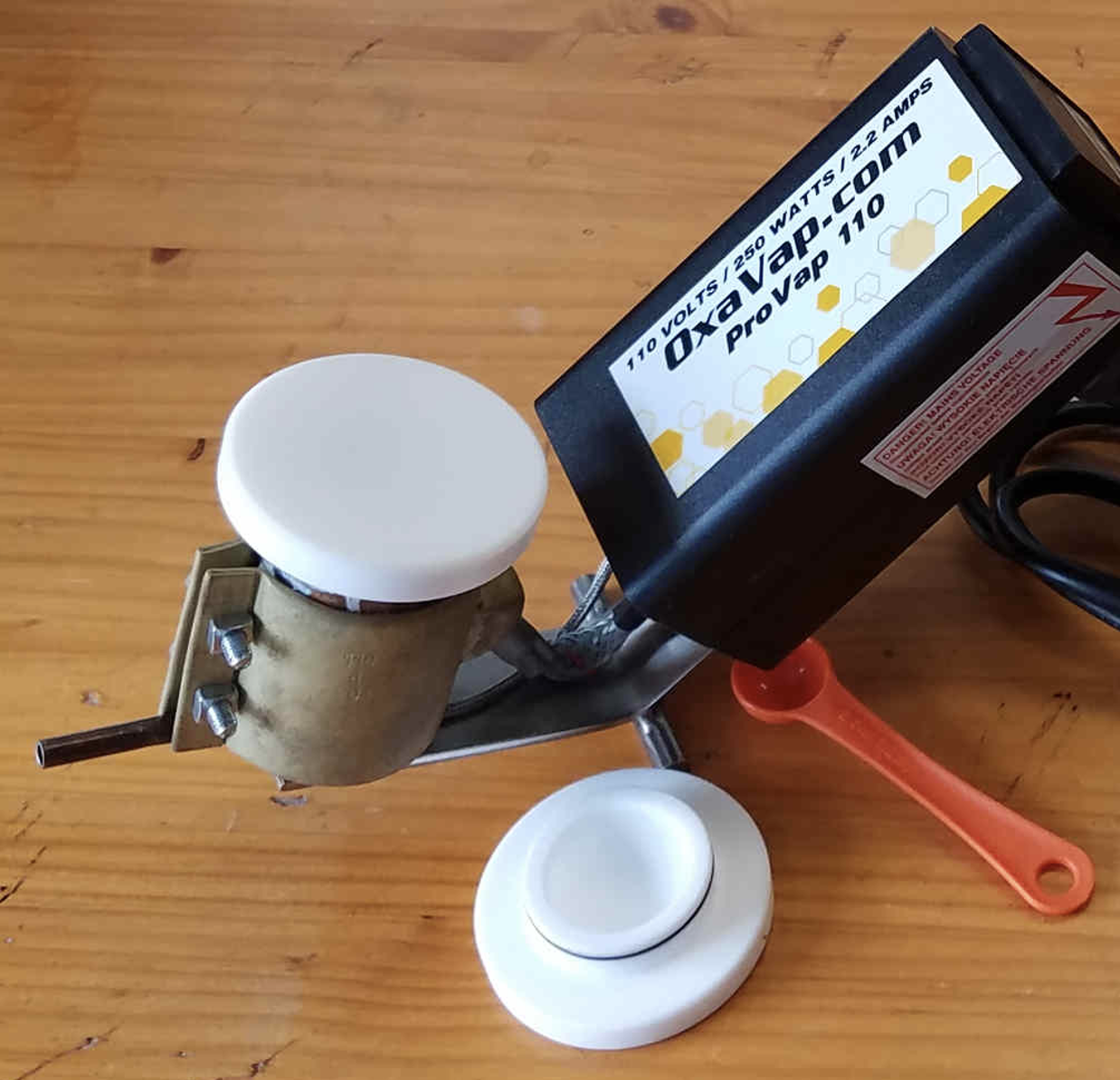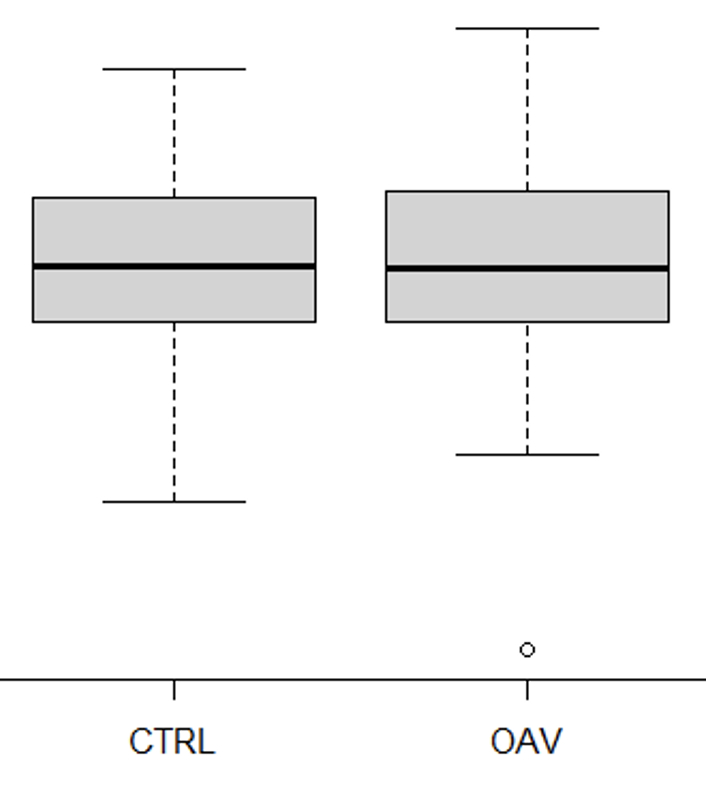for the Control of Varroa destructor in Honey Bee Colonies
Jennifer Berry
Oxalic acid has gained popularity in the United States over the years, because it is highly effective at killing V. destructor (mites) on contact, and is relatively cheap. The downside to OA, it does not penetrate the wax-capped brood cells where the majority of mites reside. The best time to apply OA and reduce mite populations is when colonies are broodless (without capped brood), thereby, rendering all mites phoretic on the adult bees and vulnerable to OA. At this time, there are three legal methods of applying OA: drip/dribble/trickle, vaporization and spraying. All three methods can be used on existing colonies, packages or swarms.
Out of these three legal methods, we have consistently used OA vaporization as our “go to for mite treatment”. For those who are not familiar with this method, let me explain. You start with a vaporizer, which is a metal wand with a plate at one end and a cord on the other which connects to a battery or other energy source. One gram of oxalic acid is placed in the metal plate and then slid into the entrance of the colony. Once connected to an energy source, the plate heats up causing the oxalic crystals to melt and turn into a gas (vaporize). The vapor will hopefully permeate the entire colony and kill any mites it encounters. There are many types of vaporizers available, but we have always chosen OxaVap vaporizers since they are built well and last. One word of caution when using a vaporizer, you must wear a respirator for safety and you Do Not want to inhale the vapor!
One popular method among beekeepers is to vaporize with OA four times, five days apart while brood is present. The rationale for this 19-day interval being that this schedule exposes all the mites as they emerge alongside their parasitized hosts, however, beekeepers still complain of little to no control after using this method. To date, there has only been anecdotal evidence that this protocol controls mites. Other studies that have examined the effect of repeated applications of the labeled rate of OA, either by liquid trickling or vaporization, have not shown OA to be effective during the brood rearing season (Gregorc et al. 2017, Jack et al. 2020, 2021). We, the UGA Bee Lab and Auburn University Bee Lab, decided to put this multiple application treatment for mites to the test. In 2019 & 2020 we tested the efficacy of repeated OA applications (seven times/five days apart) against mites during periods of brood rearing. Let’s start with the design of our study.
Experimental colonies were established and maintained in two deep Langstroth hives at the University of Georgia (UGA) Bee Lab and Auburn University Bee Lab. Prior to the beginning of the experiment, colonies were assessed and only those that were healthy with productive queens were included. Colonies were randomly assigned to one of two treatment groups: (1) vaporized with OA every five days, for seven applications or (2) an untreated control group. The seven application regimen was chosen in order to capture both worker (21 day) and drone (24 day) developmental times.
At the beginning and end of the experiment, mite levels were determined by alcohol washes. For each colony, ~ 300 adult bees were collected from the brood nest and placed into a Varroa EasyCheck device filled with alcohol. This euthanizes adult bees and phoretic mites. The container was sealed and shaken for 60 seconds to dislodge mites from the adult bees. We would count and record the number of mites settling to the bottom of the container after each wash. This process was repeated until no mites were recorded for two consecutive washes. All of the bees were counted by hand, giving an exact number of adult bees. Mites per bee was calculated by dividing the total mite count by the number of adult bees in each sample.
OA was applied to colonies by vaporization according to the label instructions for the OxaVap ProVap 110 Vaporizer. Prior to vaporization, colony entrances were sealed with blue shop towels and screened bottom boards were sealed using corrugated plastic boards. The nozzle of the device was inserted into the entrance where it remained for 30 seconds to ensure that the full dose (1g / super) was vaporized and delivered into the colony. Once completed, the device was removed and shop towels and plastic corrugated boards left in place for an additional 10 minutes per hive. For the safety of all persons applying the OA, full face respirators with OV/P100 cartridges were used and gloves were worn.
Colony strength variables (adult bees, capped brood, and honey) were measured for each colony at the beginning and end of the experiment as well. It is critical that we know the beginning and ending bee, mite and brood populations, in all colonies in order to determine how well the treatment is working and if it is harming bees and brood. After all the data was collected and analyzed, here are the results. But in a nutshell, this method of applying OA multiple times, while brood is present, did not reduce mite numbers; at best, it held them static.
Based on our results, colonies vaporized with OA multiple times did not experience a reduction in mite infestation levels, and so treatment was ineffective. Because of this, we do not recommend employing this method for controlling mites when brood is present, especially as a summer or fall treatment option when infestation levels are at or above the treatment threshold.
For a mite treatment to be successful, especially when mite populations have reached or exceeded the economic threshold, they must significantly lower mite numbers and not simply keep them at the same level, which is what our study showed. It is important for beekeepers to adopt reliable and effective treatment programs along with realistic, IPM approaches to sustainably reduce infestation levels of mites. Now, this does raise the question, if colonies are treated with vaporized OA, multiple times, well before mites levels reach the treatment threshold, can suitable mite control be achieved? Not sure, but this could explain anecdotal evidence from beekeepers that multiple applications are working.
Our second objective was to determine if multiple applications of OA in a colony have measurable effects on adult bees, brood, and stored honey amounts. Our results showed no significant differences in changes in adult bees, brood or stored honey when colonies were exposed to OA. This supports previous studies with gaseous OA (Jack 2020, 2021, Al Toufailia et al. 2015). We consider our results here to be among the strongest demonstrations of the relative safety of OA to honey bees since we vaporized seven times. Perhaps future experiments may want to explore the long-term effects and over wintering ability of colonies after being treated with increased levels of oxalic acid?
It was already widely known that the most desirable time to treat with OA is when colonies are broodless. There have been a number of studies over the years that have shown OA works when incorporated with these broodless periods, thereby rendering all mites phoretic on adult bees and vulnerable to OA (Charriere & Imdorf, 2002, Gregorc & Planinc, 2001, Gregorc et al., 2016, Gregorc et al., 2017, Rademacher and Harz, 2006). Broodless periods naturally occur when the queen seasonally stops laying eggs. Many beekeepers (commercial and backyard) take advantage of these natural brood breaks during the winter months and treat with OA to reduce mite populations. Brood-free intervals are brief or absent altogether in some warm latitudes, raising the need for alternative treatment schedules, therefore, it may be necessary to take advantage of broodless periods as part of a normal management plan, such as when making splits, requeening or forcing a brood break.
It is also a question whether 1g OA/super is an effective dose. Al Toufailia et al. (2015) working in the United Kingdom found that vaporizing with four times the US-label rate of one gram per brood box resulted in a 98.2% reduction in mite levels. Recently, Jack et al. (2021) demonstrated in Florida that colonies vaporized with 4g of OA while brood is present had significantly lower infestation levels of mites than those vaporized with only 1g per brood box. Because of these results and others, we conducted a study this summer in which we investigated vaporizing with increased doses of OA, in conjunction with and without a brood-break. We are wrapping up the analysis now and will be publishing our results soon.
Recently the EPA approved the use of OA while human consumable honey supers are on the hive. This was due in part to research revealing no increase in OA amounts in honey that had been treated with OA. This is good news. The bad news, multiple applications of OA while brood is present does not decrease mite populations, hence, is not an acceptable method for controlling mites in your colonies. Unfortunately, vaporizing with OA does not penetrate the wax capping of the brood cell where mites are reproducing and likely accounts for much of the variance in reported success with OA. Numerous applications of OA while brood is present is not capturing all the mites since they are constantly moving in and out of cells and not on a 19 or 21 day cycle. However, incorporating an OA application this winter, while colonies have little to no brood, as part of your yearlong mite treatment control program, will decrease mite populations. Please make sure to do it safely! Hope your family, your bees and you have an awesome Christmas and Happy New Year! 2022 is going to be spectacular and hopefully mite free!!!
References
Al Toufailia, H., A.L. Scandian, and L.W. Ratnieks. 2015. Towards integrated control of varroa: 2) comparing application methods and doses of oxalic acid on the mortality of phoretic Varroa destructor mites and their honey bee hosts. J. Apic. Res. 54: 108-120.
Charrière, J-D, and A. Imdorf. 2002. Oxalic acid treatment by trickling against Varroa destructor: recommendations for use in central Europe and under temperate climate condition. Bee World. 83: 51-60
Gregorc, A., J. Adamczyk, S. Kapun, and I. Planinc. 2016. Integrated Varroa control in honey bee (Apis mellifera carnica) colonies with or without brood. J. Api. Res. 55: 253-258.
Gregorc, A., M. Alburaki, C. Werle, P.R. Knight and J. Adamczyk. 2017. Brood removal or queen caging combined with oxalic acid treatment to control varroa mites (Varroa destructor) in honey bee colonies (Apis mellifera). Apidologie. 48: 821-832.
Gregorc, A., and I. Planinc. 2001. Acaricidal effect of oxalic acid in honeybee (Apis mellifera) colonies. Apidologie. 32: 333-340.
Jack, C.J., E. van Santen, and J.D. Ellis. 2021. Determining the dose of oxalic acid applied via vaporization needed for the control of the honey bee (Apis mellifera) pest Varroa destructor. J. Api. Res. DOI:10.1080/00218839.2021.1877447.
Jack, C.J., E. van Santen, and J.D. Ellis. 2020. Evaluating the efficacy of oxalic acid vaporization and brood interruption in controlling the honey bee pest Varroa destructor (Acari: Varroidae). J. Econ. Ent. 113: 582-588.
Rademacher, E., and M. Harz. 2006. Oxalic acid for the control of varroosis in honey bee colonies – a review. Apidologie. 37: 98-120.








